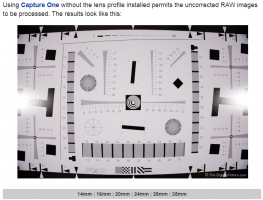I wonder how that can be legal.
What will happen if you do not use DPP, but Lightroom instead? Will the distortion be visible or will Canon produce a fake RAW to hide the distortion?
1) Because they don't claim it is corrected optically. If Canon wrote "this lens is corrected for distortion optically and does not rely on software correction" then yes, this would be illegal; that's the very definition of false advertising. But they don't say that. All they say in their advertising is that it has "excellent optical performance". Since they don't specify distortion, just optics in general, they're technically above-board.
If someone wanted to build a case with trading standards against Canon's advertising, they'd be better off going after the 85mm f/2 IS (which Canon still claims is both "compact" and has "quiet" AF, which anyone who's so much as glanced at it knows are two completely erroneous claims). Even then, that's more indiciative of a wider industry problem than anything specific to Canon. Every manufacturer needs to shape up. (If you think Canon's advertising is misleading, go check out Fujifilm, oh boy.)
2) Lightroom's adherence to Canon's opcodes is pretty random. With some lens and body combinations Lightroom will follow Canon's adjustments, and with other combos Lightroom does entirely its own thing. Capture One more consistently follows Canon's opcodes, though still not every time as Bryan has demonstrated with his particular lens. If you want to have all the corrections, using a manufacturer's own software is always the most accurate solution, though it's very rare for Lightroom to not recieve a 99.9% accurate profile within a couple of weeks of a lens being on store shelves. DxO's Pure Raw is also very good for correction distortion and much better than DPP for cleaning up noise at the same time, though it does result in files twice as large and it's not really worth buying unless you're dead-set on having the most absolutely 100% perfectly-corrected files possible. Raw Therapee is the best software for totally bypassing any opcodes and seeing the raw file as 'raw' as possible.
By the way, every raw is a "fake raw". The R5 has opcodes for noise reduction and exposure boosting, hiding the fact its real sensitivity is much lower than it states. Sony raws have opcodes for sharpening and saturation boosts. Fuji raws have opcodes for damn well everything and anything you can name, but most notably extremely strong chromatic noise reduction. Nikon raws have opcodes for distortion, noise
and sharpening, though generally (varies by camera model) to a lesser extent than Sony's sharpening or Fuji's and Canon's noise reduction. I've not pulled apart raw files form Panasonic or Olympus in a good while but I'm willing to bet their files are full of opcodes for all kinds of hidden adjustments, too. There's not actually any such thing as a truely "raw" file. Any raw file you look at has been through
some form of processing, which at the bare minimum includes a subjective evaluation of colour and contrast just in order to turn all the 1s and 0s into a picture you can actually see. Raw Therapee can show you a file without demosiacing and opcodes, but then you just get a pixelated mess which you really can't use.
Anyway.
This does still take the piss quite a bit considering how much more expensive this is than the EF equivalent. They're charging £1750 for this, while the EF f/4L IS is £999 (and of course much less used) and third-party equivalents are cheaper again. Granted, this 14-35 is the (fractionally) smaller than the EF and gives you an extra 2mm, but I've never been in a situation where 16mm wasn't already too wide and it's not like the EF lens was ever prohibitively large or heavy. (And there's the Tamron f/2.8-4 which is even smaller and lighter than the RF lens, granted with 3mm less on the widest end.)
For this lens to justify costing 80% more it had to
really deliver, and this doesn't seem to, regardless of whether it's relying on software or not. I'm not seeing any extra resolving power here and Bryan's testing demonstrates more fringing than the EF lens even with all the corrections, slightly more vignetting, more flare wash-out,
and more distortion... nah, that's not a £1750 lens. I don't care that it's 100g lighter and 1cm shorter, nor do I care that it brings with it an extra 2mm. (Though looking at these results I'm betting it's not a full 14mm, at least not after such heavy correction.) Those elements I'd pay, at most, £150-200 more for, given the end results are about the same quality. £750 extra is a bad, bad joke.
Buy the EF (or the Tamron), and spend the saved money on a trip somewhere you'll actually get use out of the lens, or get some really nice ND filters, or just pocket it and save it for the next lens. Nobody should be paying £1750 for this and I feel very sorry for the poor saps who blindly pre-ordered. Hopefully people will learn, stop pre-ordering lenses, and force manufacturers to actually deliver some real value. These are £999 results in a £1750 shell... just don't do it. Don't. This is silly.
So much for mirrorless providing better optimisation for wide-angle lenses. It's bizarre and somewhat ironic that its been telephoto which has benefitted most since the move to mirrorless, even though telephoto formulas don't actually benefit from the shorter flange distance.

